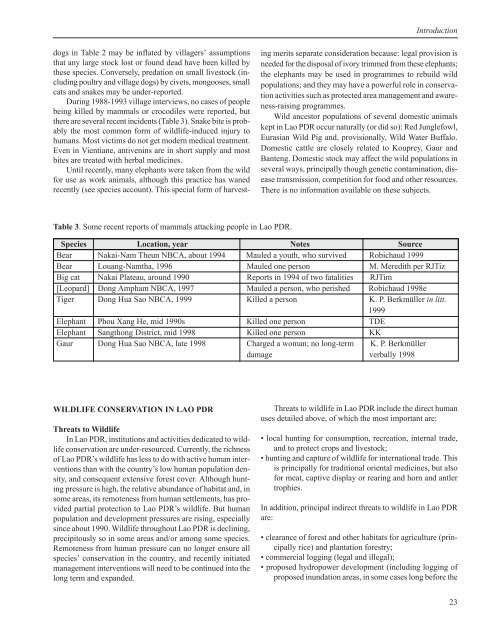Wildlife of Lao PDR: 1999 Status Report - IUCN
Wildlife of Lao PDR: 1999 Status Report - IUCN
Wildlife of Lao PDR: 1999 Status Report - IUCN
Create successful ePaper yourself
Turn your PDF publications into a flip-book with our unique Google optimized e-Paper software.
dogs in Table 2 may be inflated by villagers’ assumptions<br />
that any large stock lost or found dead have been killed by<br />
these species. Conversely, predation on small livestock (including<br />
poultry and village dogs) by civets, mongooses, small<br />
cats and snakes may be under-reported.<br />
During 1988-1993 village interviews, no cases <strong>of</strong> people<br />
being killed by mammals or crocodiles were reported, but<br />
there are several recent incidents (Table 3). Snake bite is probably<br />
the most common form <strong>of</strong> wildlife-induced injury to<br />
humans. Most victims do not get modern medical treatment.<br />
Even in Vientiane, antivenins are in short supply and most<br />
bites are treated with herbal medicines.<br />
Until recently, many elephants were taken from the wild<br />
for use as work animals, although this practice has waned<br />
recently (see species account). This special form <strong>of</strong> harvest-<br />
Table 3. Some recent reports <strong>of</strong> mammals attacking people in <strong>Lao</strong> <strong>PDR</strong>.<br />
ing merits separate consideration because: legal provision is<br />
needed for the disposal <strong>of</strong> ivory trimmed from these elephants;<br />
the elephants may be used in programmes to rebuild wild<br />
populations; and they may have a powerful role in conservation<br />
activities such as protected area management and awareness-raising<br />
programmes.<br />
Wild ancestor populations <strong>of</strong> several domestic animals<br />
kept in <strong>Lao</strong> <strong>PDR</strong> occur naturally (or did so): Red Junglefowl,<br />
Eurasian Wild Pig and, provisionally, Wild Water Buffalo.<br />
Domestic cattle are closely related to Kouprey, Gaur and<br />
Banteng. Domestic stock may affect the wild populations in<br />
several ways, principally though genetic contamination, disease<br />
transmission, competition for food and other resources.<br />
There is no information available on these subjects.<br />
Species Location, year Notes Source<br />
Bear Nakai-Nam Theun NBCA, about 1994 Mauled a youth, who survived Robichaud <strong>1999</strong><br />
Bear Louang-Namtha, 1996 Mauled one person M. Meredith per RJTiz<br />
Big cat Nakai Plateau, around 1990 <strong>Report</strong>s in 1994 <strong>of</strong> two fatalities RJTim<br />
[Leopard] Dong Ampham NBCA, 1997 Mauled a person, who perished Robichaud 1998e<br />
Tiger Dong Hua Sao NBCA, <strong>1999</strong> Killed a person K. P. Berkmüller in litt.<br />
<strong>1999</strong><br />
Elephant Phou Xang He, mid 1990s Killed one person TDE<br />
Elephant Sangthong District, mid 1998 Killed one person KK<br />
Gaur Dong Hua Sao NBCA, late 1998 Charged a woman; no long-term K. P. Berkmüller<br />
damage verbally 1998<br />
WILDLIFE CONSERVATION IN LAO <strong>PDR</strong><br />
Threats to <strong>Wildlife</strong><br />
In <strong>Lao</strong> <strong>PDR</strong>, institutions and activities dedicated to wildlife<br />
conservation are under-resourced. Currently, the richness<br />
<strong>of</strong> <strong>Lao</strong> <strong>PDR</strong>’s wildlife has less to do with active human interventions<br />
than with the country’s low human population density,<br />
and consequent extensive forest cover. Although hunting<br />
pressure is high, the relative abundance <strong>of</strong> habitat and, in<br />
some areas, its remoteness from human settlements, has provided<br />
partial protection to <strong>Lao</strong> <strong>PDR</strong>’s wildlife. But human<br />
population and development pressures are rising, especially<br />
since about 1990. <strong>Wildlife</strong> throughout <strong>Lao</strong> <strong>PDR</strong> is declining,<br />
precipitously so in some areas and/or among some species.<br />
Remoteness from human pressure can no longer ensure all<br />
species’ conservation in the country, and recently initiated<br />
management interventions will need to be continued into the<br />
long term and expanded.<br />
Introduction<br />
Threats to wildlife in <strong>Lao</strong> <strong>PDR</strong> include the direct human<br />
uses detailed above, <strong>of</strong> which the most important are:<br />
• local hunting for consumption, recreation, internal trade,<br />
and to protect crops and livestock;<br />
• hunting and capture <strong>of</strong> wildlife for international trade. This<br />
is principally for traditional oriental medicines, but also<br />
for meat, captive display or rearing and horn and antler<br />
trophies.<br />
In addition, principal indirect threats to wildlife in <strong>Lao</strong> <strong>PDR</strong><br />
are:<br />
• clearance <strong>of</strong> forest and other habitats for agriculture (principally<br />
rice) and plantation forestry;<br />
• commercial logging (legal and illegal);<br />
• proposed hydropower development (including logging <strong>of</strong><br />
proposed inundation areas, in some cases long before the<br />
23

















